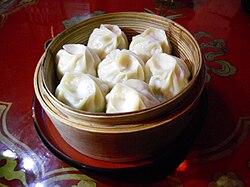food.wikisort.org - Dish
Buuz (Mongolian: Бууз; Buryat: Бууза/Buuza, [ˈbʊːt͡s(ɐ)], Chinese: 包子/Baozi) is a type of Mongolian steamed dumpling filled with meat. An example of authentic Mongolian and Buryatian cuisine, the dish is traditionally eaten at home during Tsagaan Sar, the Lunar New Year. These days it is also offered at restaurants and small cafes throughout the capital city of Ulaanbaatar.[1]
 | |
| Type | Dumpling |
|---|---|
| Place of origin | Mongolia, Buryatia |
| Main ingredients | Dough, mutton, or beef |
History and function
Buuz is the Mongolian version of the steamed dumpling which is commonly found throughout the region. Etymologically, it reveals its origin to China, as baozi (Chinese: 包子; pinyin: ![]() bāozi) is the Mandarin word for steamed dumpling. They are eaten in great quantities throughout the year but especially during the Mongolian New Year celebrations, which usually fall in February. Buuz are prepared in the weeks before and left outside to freeze; they are consumed with salads and fried bread, accompanied by suutei tsai (Mongolian tea) and vodka.[2]
bāozi) is the Mandarin word for steamed dumpling. They are eaten in great quantities throughout the year but especially during the Mongolian New Year celebrations, which usually fall in February. Buuz are prepared in the weeks before and left outside to freeze; they are consumed with salads and fried bread, accompanied by suutei tsai (Mongolian tea) and vodka.[2]
Ingredients and preparation



Buuz are filled with minced mutton or beef, which is flavoured with onion and/or garlic and salted. Occasionally, they are flavoured with sprouted fennel seeds and other seasonal herbs. Mashed potato, cabbage, or rice may be added as well.
The meat ball is then placed inside a small pocket of dough which is folded around the ball with a small opening at the top and in the chef's own personal style. The buuz is then steamed and eaten by hand, with the dough pocket catching the juices of the meat.
The filling in buuz is similar to another Mongolian dumpling, khuushuur; however, the latter is fried.
See also
- Khuushuur
- Gürzə, the Azerbaijani equivalent
- Khinkali, the Georgian equivalent
- Gyoza, the Japanese equivalent
- Jiaozi and baozi, Chinese equivalents
- Mandu, the Korean version
- Mantı, the Turkic/Central Asian version
- Modak, the Indian equivalent
- Momo, Nepalese & Tibetan equivalent
- Pelmeni, the Russian equivalent
- Vareniki, the Ukrainian/Polish/Lithuanian equivalent
- List of steamed foods
References
- Slater, Judith J. (2004). Teen Life in Asia. Greenwood. p. 118. ISBN 9780313315329. Retrieved 10 February 2013.
- Williams, Sean (2006). The Ethnomusicologists' Cookbook: Complete Meals from Around the World. CRC Press. p. 59. ISBN 9780415978194. Retrieved 10 February 2013.
External links
- Buuz recipe from mongolfood.info
На других языках
- [en] Buuz
[es] Buuz
El buuz (en mongol, Бууз; en buriato, Бууза, Buuza; pron. boze) es un pan cocido al vapor muy popular de la cocina mongola. Este tipo de pan se suele rellenar con carne picada de cordero, aunque existen variantes de carne de vaca o de yak. La carne se encuentra picada y es elaborada como una albóndiga junto con cebollas y ajo bien picado. La carne se incluye en una especie de "bolsillo" de masa de pan y se enrolla en la parte superior, la forma final depende de las costumbres y habilidades del cocinero. El buuz se suele cocinar al vapor y se suele comer con las manos.[1][ru] Позы
По́зы[1], буузы (бур. бууза, монг. бууз) — традиционное бурятское и монгольское блюдо, также популярное в Иркутской области и Забайкальском крае.Другой контент может иметь иную лицензию. Перед использованием материалов сайта WikiSort.org внимательно изучите правила лицензирования конкретных элементов наполнения сайта.
WikiSort.org - проект по пересортировке и дополнению контента Википедии